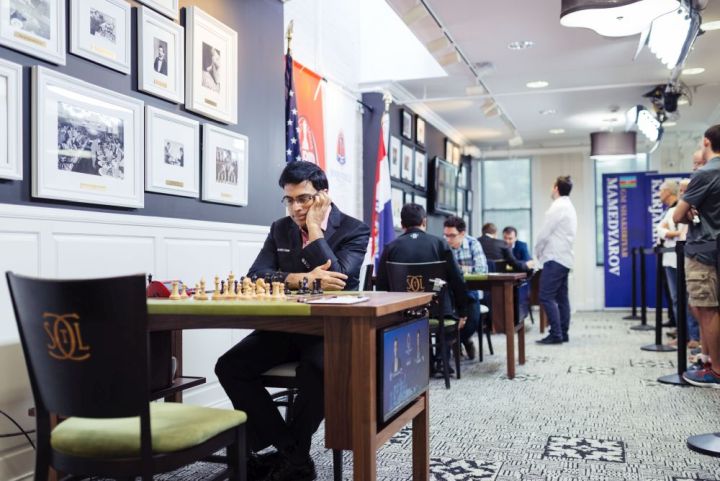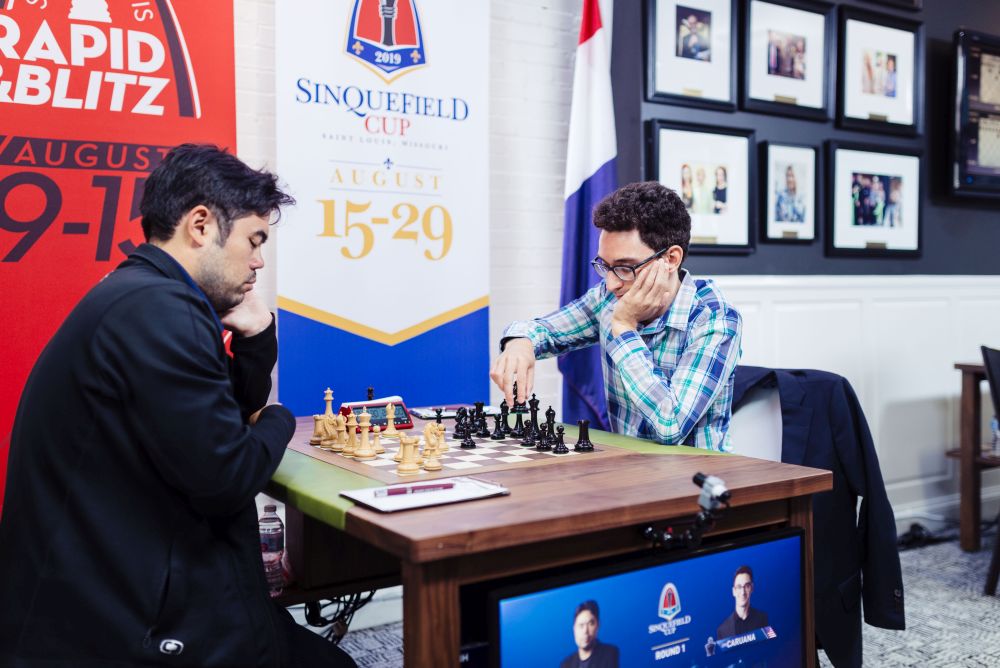


Vishy Anand's persistent pressure resulted in Ian Nepomniachtchi blundering in the fifth hour to give the former world champion a dramatic victory after 77 moves in the first round of the Sinquefield Cup. All the other games ended in draws almost without any gripping fights in an otherwise quiet day.
The game with least momentum turned out to be Karjakin vs Mamedyarov, which started with the rare Scandinavian Defence. But there was only one moment in the game which seemed to be passed up too soon by the players.

When both Karjakin and Mamedyarov are spectators too | Photo: Crystal Fuller / Grand Chess Tour
Ding vs So was a long fight, and the Chinese superstar seemed to miss an easy path to advantage.

Ding Liren – Tired after the Rapid & Blitz? | Photo: Crystal Fuller / Grand Chess Tour
Was it a result of any tiredness experienced from finishing 27 games of Rapid & Blitz just a couple of days before? “I think I rested well yesterday. Today I came (to the board) with a good mood. I just missed (a) little chance”, asserted Ding. Only the coming rounds will reveal more about that.
The pairing between Magnus Carlsen and Anish Giri was an anticipated clash for two reasons:

Carlsen – Giri: Lord of the tweets or fight of the Trolls? | Photo: Austin Fuller / Grand Chess Tour
The earliest draw of the day was even more disappointing. Fresh from their gripping fights in the Saint Louis Rapid & Blitz, Levon Aronian and Maxime Vachier-Lagrave were paired against each other in the very first round. Aronian is the most successful player in the history of elite tournaments at Saint Louis — twice winner of the Sinquefield Cup (once the sole winner and the other a shared title) and twice winner of the Saint Louis Rapid & Blitz. And, coming as it does that MVL has to give his best shot in the current tournament for any chance of qualifying for the GCT final, and also that he defeated Aronian in the final round of blitz just a couple of days ago, the game was anticipated with interest.
And there was added biz after the secret of MVL's fresh look was leaked on Twitter by IM Daniel Rensch!
For those that might wonder where this fresh, young looking @Vachier_Lagrave came from today at the #SinquefieldCup #grandchesstour — look no further than a bet he lost to me (with a shave on the line)... pic.twitter.com/qMsPqt5pJK
— Daniel Rensch (@DanielRensch) August 17, 2019
The game developed into a complex middlegame struggle and MVL seemed to be taking the plunge playing for the initiative.
15...g5!?
Even though it does not alter the evaluation of the position, the move has its psychological effect — black can no more be considered as the traditional side which plays for equalizing, but the one poised to take over the initiative with active play.
The move energized the audience, and when a complex pawn structure leading up to a messy position was reached, the protagonists were expected to fight to their best.
But much to the disappointment of all, the players repeated moves here with 22.♘f1 ♝e4?! 23.♘d2 ♝d3 twice to settle for a draw.
Aronian admitted after the game that he didn't like his position so much. Was he worried that white's position didn't look very sound if Black had continued 22...♝g6? “I wasn't too worried. I always felt that with the (black) pawn on g5 and other (factors), it was not easy to make progress with both colours — should be kind of balanced”.

Aronian vs Vachier-Lagrave — just when things got interesting | Photo: Crystal Fuller / Grand Chess Tour
One of the most interesting games of the day was between the two American Olympians, Hikaru Nakamura and Fabiano Caruana. Though Nakamura squandered his slight opening advantage, he showed his fighting intentions with ambitious play in the late middlegame.
29.♘g4 ♝e6 30.h6+!? ♚f7 31.♘e3 and the game developed a lot of interest.
Nakamura too claimed after the game that he felt Caruana's play wasn't precise to allow the white pawn to reach up to h6. After all, how can a game not produce a result after white parks a pawn on h6 — either he should be able to attack the black king, or it will be gobbled up by black in the endgame, right!?
However, Caruana kept his cool to defend the position once he forced an endgame.
35...g5! 36.♖a7+ ♚g6 37.♖a6 ♚f7 and black held the draw soon. After the game, Nakamura observed a curious fact, “Maybe, it was a Magnus kind of position where if you get the right kind of setup you can press forever, but I didn't really see it during the game”. It was interesting to hear Nakamura sum up the kind of effect the world champion has on chess technique in general.

Nakamura vs Caruana — an all-American fight | Photo: Crystal Fuller / Grand Chess Tour
Nepomniachtchi vs Anand was a fascinating struggle right from the word go. After all, Anand introduced an almost-novelty on the fifth move itself offering a pawn sacrifice.
When I asked him after the game if the move was a prepared surprise, he came up with a fascinating insight:
Yes, I guess we had both looked it, as he played 6.♘c3 more or less immediately. (And) rather embarrassingly, I was out of my preparation immediately at that! I realised that, after 6...♞bd7, you are a tempo up in an Old Indian (Defence), but what am I going to do with (an extra) tempo in this passive opening!?
In the queenless middlegame, Anand showed his deep understanding of the position by expanding on the kingside rather than playing to equalize in the centre with the typical push ...d5-d4. Resembling one of those classic games of Rubinstein where black gains space on the kingside to keep white on tenterhooks.
By continuing with 20...♚f7!? and a further ...g7-g5 & ...h7-h5 soon, Anand showed his remarkable understanding of the position. In a post game chat, I had a very enjoyable time probing on the way he conducted the play at this point.
On one hand, I am trying to equalize with ...d5-d4. On the other hand, I realized that there is very little he can do, his Knight (on f3) and Bishop (on g3) are horrible. And I can continue with (my expansion on the kingside) as it happened in the game. In theory, there are pleasant endgames waiting in the wings. I may get them or I may not, but that's what I was aiming for.
Was it the exact point where he realized that he could push for an advantage?
I tried to keep in mind that my only aim here is not just to equalize! Even if I (just) keep making moves it is not easy for white. As you can see, at some point (white) runs out (of moves). (White) can play ♗d3-c2, but the other bishop has no useful moves.
Fantastic understanding of a genius!

Nepomniachtchi in his charming Chonmage hairstyle | Photo: Lennart Ootes / Grand Chess Tour
It went into a fascinating endgame where Anand held the advantage for a long time, but couldn't really convert it into a win. In a clearly dominating position, he missed his chances to find an outright win, as he had only 4 minutes remaining on his clock against his opponent's 20.
This was probably the most strategically clear-cut win Anand missed over the board. The win is found – of course, with the help of an engine, analysing without any time pressure – by applying the logic that in any ending with a rook, the win is achieved by activating the rook!
51...♜c6! (Anand went wrong with 51...♜e7?!) 52.♔a2 (White can't do much here) 52...♚g2 53.♗e1 ♜c4 54.♔b3 ♜e4! 55.♖d1 f5 and white is bound hand and foot.
But it was probably next to impossible to find a sophisticated plan in a tough system with only a single time control, where one cannot gain time in the clock too. The GCT follows the time control of the whole game conducted in 130 minutes with a 30-second delay per move from move 1.
And when finally reached a position where he no more had a win, lady luck smiled on him.
Now, white had to simply arrange ♖a8 followed by a6 with the inevitable draw (e.g. 77.♔c5 ♜d7 78.♖a8 ♚f5 79.a6). But Nepomniachtchi — in a combination of being exhausted himself into the fifth hour of play and having the relaxed feeling of reached a draw already — blundered with 77.♔c4?? b5+! and resigned immediately, as he loses the rook after 78.axb6 ♞xb6+.

Vishy Anand — having the last laugh | Photo: Lennart Ootes / Grand Chess Tour
There was no more prosaic explaining of the turnaround than the tweet by GM Romain Edouard.
#shithappens https://t.co/5drIDsuD0M
— Romain Edouard (@romain_edouard) August 17, 2019
IM Lawrence Trent reviews the first round action